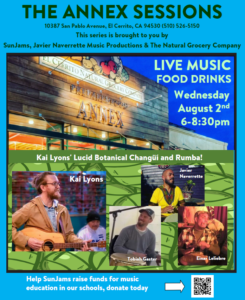Wednesday, August 2, 2023, 6-8:30pm will continue our music series held at El Cerrito Natural Grocery Company Prepared Food Annex (The Annex) – “The Annex Sessions”
Kai Lyons’ Lucid Botanical Changüí and Rumba!
Featuring:
Kai Lyons- tres
Einar Leliebre (Tito)- vocal, percussion
Tobiah Gaster- percussion
Javier Navarrette- percussion
Rumba and Changüí are two distinct and vibrant genres of Cuban music, each with its own unique characteristics and cultural heritage. When these two styles meet, it can lead to an exciting fusion of rhythms and sounds that showcase the richness of Cuban musical traditions.
Rumba is a rhythmic and percussive genre of Cuban music that originated in the Afro-Cuban communities during the colonial era. It is deeply rooted in African rhythms and traditions brought to Cuba by enslaved Africans. Rumba typically involves complex polyrhythms, call-and-response vocals, and dynamic dance movements. There are three main styles of Rumba: Yambú (slow and solemn), Guaguancó (more energetic and flirtatious), and Columbia (fast-paced and virtuosic).
Changüí is another Cuban music genre that emerged in the eastern region of the country, particularly in Guantanamo and Santiago de Cuba. It has rural origins and is considered one of the foundational styles of modern Cuban music. Changüí features a combination of African and Spanish influences and is often played by small groups consisting of guitar-like instruments called tres, maracas, bongos, and güiro. It has a lively and danceable character, with a repetitive and syncopated rhythmic structure.
When Rumba meets Changüí, we can expect a blend of these two distinct rhythmic traditions. The polyrhythmic complexity of Rumba might merge with the syncopated patterns of Changüí, creating a fascinating interplay of percussion and instrumentation. The call-and-response vocal elements of Rumba could also intertwine with the melodic lines of Changüí, adding a layer of vocal interaction to the music.
Moreover, the fusion of Rumba and Changüí may lead to the creation of new dance styles or variations, as both genres are deeply connected to dance forms. The resulting music would likely be infectious, rhythmically engaging, and evoke a sense of celebration and cultural heritage.
It’s important to note that Cuban music is incredibly diverse and continues to evolve through various fusions and influences. The meeting of Rumba and Changüí is just one example of how Cuban musicians continually explore and experiment with their musical heritage. The outcome of such a fusion would depend on the creativity and artistry of the musicians involved, adding their own unique touch to the blend of these two remarkable Cuban music styles.
The Natural Grocery Company is proud to present this series in partnership with SunJams and Javier Navarrette Music Productions.
SunJams is committed to funding children’s music education in underserved public elementary schools. Your donation will help support this ongoing program.
All of the proceeds will go directly to our network of local musicians, each of whom have been severely impacted by the lack of events during the COVID-19 pandemic.
Whether you donate $10, $100, or $1000 – any amount helps and will allow us to keep bringing music to our community! As always, your donation to SunJams 501(c)3 may qualify as tax exempt.
Javier Navarrette Music Productions continues to bring live music to several venues around the Bay Area. Javier has been a professional musician and music educator in the Oakland Unified School District for the past 20 years. Over the past few years Navarrette has produced outdoors events that have proven instrumental in enabling musicians to deal with some of the fallout of the pandemic and shutdown that followed.
COVID RELATED SAFETY MEASURES
Please be safe. Feel free to wear a mask if you prefer.
TICKETS
Tickets are NOT required for this venue, you can simply come in, order food and beverages at the Annex counter and pay at the registers.


